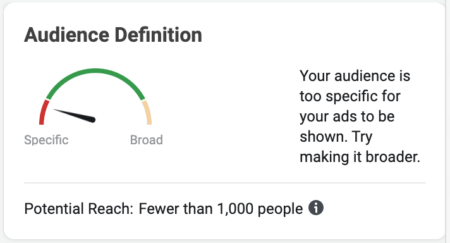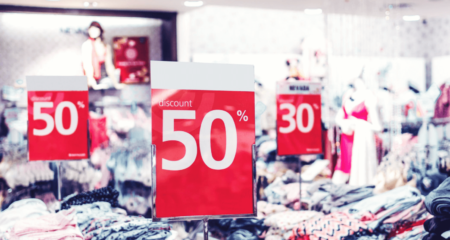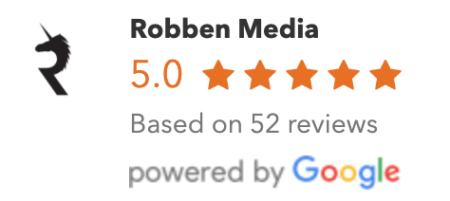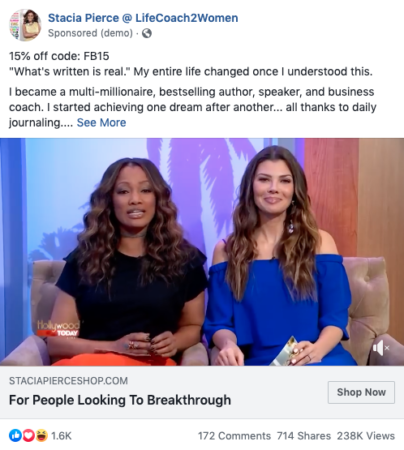Facebook Ads Not Converting? 13 Reasons Why & Fixes

Are your Facebook ads not converting? And is it your fault, bad luck, or what’s the problem?
You’re going to learn the most common Facebook ads mistakes and how to fix it for good. Once you make these changes, it’s not unreasonable to triple your return on ad spend.
Reasons Facebook Ads Don’t Convert
1. Ad spend is too low
At the minimum, you want to spend anywhere from $2,000 to $3,000 per month on your monthly advertising budget. Anything lower will return less-than-optimal results. For example, some clients in our Facebook ads agency attempt spending $1,500 per month, but the second they increase the budget the net results improve dramatically.
![]()
How to fix:
This is an easy one. Simply increase the campaign ad spend to a higher total to start producing better results. And if you don’t believe you can afford to run ads at this amount of spend, then focus on sales to build up a higher cash reserve until you can.
2. Unsure of target audience
The Facebook advertising algorithm is only as effective in its output as the initial input you give it. In plain English, you need to 100% know your target audience and then communicate who that audience is when you’re setting up your ads.
Startups and new business owners frequently struggle with this piece. Of course your ads are going to fail when you don’t have a firm grasp of the following:
- Who your customers are
- Where they spend their time
- Why they buy from your business
- The language they use to describe their pain points
- How the product or service transforms your audience’s life
Without knowing the answers to these questions, it’s very difficult for even the best advertisers in the world to make money. Before running more ads, do some customer research.
How to fix:
There’s no growth hack for this one. You, or someone on your team, needs to do the manual work of calling customers, sending surveys, and asking buyers the following questions.
- Why do you buy from us?
- What’s your favorite product or service?
- Do you consider our pricing expensive, average, or affordable?
- How does our product or service address a need in your life?
- How did you hear about us?
Once you have a good sample size of 20 or more responses, then look for patterns. Assuming you have a good grasp of who your audience is and what they desire, now you can go back to the Facebook ads manager to select better targeting.
3. Narrow audience targeting
The flip side of this coin is being overconfident in your ability to target audiences. When you put 27 different audience parameters in an ad, you’re severely limiting the results. The Facebook algorithm has little room to operate. Meaning the profitability of your ads will most likely suffer.

Given a choice between too narrow or too broad, I’d choose a broad audience over a narrow one every time. The odds are more in my favor that the algorithm will find people interested in my ad and click through to the landing page.
How to fix:
For most national campaigns, you should have at least 500,000 people in your target audience. This gives the algorithm plenty of opportunity to perform. Any smaller of an audience size is doing your campaign a disservice.
Of course, a regional retail shop will have a different audience size. The general rule of thumb is too shade too big over too small.
4. Value isn’t clear
Unclear value propositions never work! Even average value statement’s struggle to drive clicks and sales. (I tell my SEO agency clients this all of the time.)
The value your product or service brings to the buyer needs to be crystal clear. Value should pop off the page.
You want the customer to feel like they’re stealing from you and wonder if you’ve lost your mind. By going the extra mile, the value statement will incentivize audiences to buy. Plus, encourage them to tell their friends and come back for more.
How to fix:
Before ever writing an ad, draft your value statement. For an example using Robben Media, ours is we help businesses scale by turning online advertising into profit.
The value is scaling your business. The audience is business owners and executives. And the activity is using digital marketing to bring in higher profits.
If you need help determining your value statement, fill in the blanks of this sentence:
My business helps (this audience) to (accomplish this goal) using (this product or service).
5. There’s no story or excitement around the offer
Would you use these words to describe your ad: emotional, interesting, exciting, insightful, and entertaining? If note, it’s likely your ads are boring. And what goes through the customer’s head is if the company selling the product or service isn’t thrilled with it, then why would I get excited?
How to fix:
See where you can spice up the language in your ad. People don’t buy products or services. They buy life transformations and better futures.
How can your ad copy elude to the idea that their future will be better after an exchange with your company? Mention the benefits to their confidence, wealth, health, or happiness. Excitement gets other people intrigued.
Not just in your ads, but overall it’s wise to lead your customers to see the wonder in your offer. When you execute in this manner, not only will you make more money, you’ll have more fun. Apple does this better than anyone.
6. Asking for the sale too early

Ever run into someone on the street and ask them to bed? That’s exactly what you’re doing when your first impression is asking a stranger to buy.
Now that’s not to say never run sales-focused ads. But there’s an art to doing this. The best ads lead with value, clearly show the benefits, and then once the prospect is certain, then they will ask for a sale.
How to fix:
Put yourself in the shoes of your prospect. Now, look at your ad and landing page through the lens of does this make my life better? Did I learn anything? If the answer is yes, you’re in good shape. If the answer is no, all that you see is a sales pitch, then revise your ad.
Tell a story. Teach about an applicable moment in history. Show something new in your ad copy. All of this is better than going immediately for a sale.
Another idea is to only sell use retargeting campaigns. This way you know you’re not asking for the sale on your first interaction.
7. Weak call to action
Aggressive is one thing. The other way to lose sales opportunities is to never ask for the sale at all.
Poor, zero, or too many calls to action are often the culprit of why your Facebook ads don’t convert. One of the worst mistakes is to put the onus on your prospect to figure out the next steps to purchase. Confusion is always bad for business.
Don’t force, but lead your potential buyers to purchase.
How to fix:
First identify what is the sales process. If it’s ecommerce, that’s easy with an ad to a product page. But for others, it often makes more sense to go from ad, to an opt-in form, to a webinar, to a sales page.
When setting up your funnel, ensure the call to actions are clear each and every time. It’s easy to miss, and difficult to recover from. Then end your ads with one clear call to action. Not two, just one.
8. Social proof is missing
Be it 5 star ratings, video testimonials, or customer reviews, social proof is a timeless addition to any marketing campaign. I’ve never seen someone add social proof and the campaign does worse. It’s the opposite, social proof drives revenue.

Why? As you can imagine, no one wants to be the first person to buy something. In having social proof in your ad, and landing page, you derisk the sale and increase conversions. Not to mention, social proof should be featured heavily across your website design.
How to fix:
Besides the audience taking you at your face value, what in your ad and landing page builds credibility?
Have you personally made millions of dollars using your real estate investing strategy? Show that bank account in a screenshot.
Have you helped families save 30% on their health insurance? Get a video testimonial from to use as your ad.
Does your product have amazing reviews? Include the total and the best review in your ad copy.
9. Awful advertising creative
Are your ads full of pictures with graphics, colors, and other unnecessary elements? That’s a red flag. Because your ads should look like a friend posted on the News Feed. The goal is to be authentic and real, not salesy and fake.
Too fancy of creative — looking at you with the Lamborghini and Rolex — will also raise the suspicion that your offer is too good to be true. Your ad creative shouldn’t look like a Time Magazine cover.
How to fix:
Ensure your Facebook advertising creatives match the content in your ad copy, in a natural and authentic way. For example, if you’re a coach selling a course, then show an image, or play a short video clip, of you training people. This creates consistency with the audience’s expectations. And doing that increases conversions.
10. Videos haven’t been tested
If you’re not utilizing video ads this year and going forward, you’re missing out on a higher return on ad spend (ROAS).
Videos are supreme for communicating a message or showing off a product. Audiences often engage more compared to pictures. Plus, Facebook, in its efforts to compete with YouTube, often gives more exposure to videos.

How to fix:
Add a few videos to your ad campaign to test the effectiveness. If you’re in a visual business like the food, real estate, or fitness industry, then video ads are the best content.
For example, a realtor can record a virtual tour of them going through a property they’ve listed and calling out the unique home features. This information blows an image out of the water.
11. No landing page
A true rookie mistake is running ads to your website’s home page. Often home pages are generic, informational, and provide the mission statement.
But, they are by no means the best page to convert traffic into sales. You’ll want to build and send traffic to a specific landing page that matches the ad’s call to action.
How to fix:
Create a specific landing page with a headline, 2-4 sentences of key benefits, and then a clear call to action to watch a video, enter their email, or purchase. We wrote an entire guide on the best landing pages if you want more information.
12. Landing page doesn’t match the ad
Buyers are looking for consistency from start to finish. When there’s an exclusive offer on a Facebook ad, the prospect clicks, and the landing page doesn’t match those expectations, you just lost the sale.
People are too busy to click around looking for the deal they were promised on the previous screen.
Be a true professional by giving your prospect a seamless buying experience. This will enhance your credibility and sales volume.
How to fix:
Ensure the heading in your ad closely matches your landing page’s title. Next, ensure the main benefits listed in the ad make their way on the landing page too. Also, it’s a good idea to have the ad creative match the landing page image or video.
You’ll know you’ve nailed this when there are no surprises from your ad to your landing page.
13. Forgetting to utilize retargeting ads
On average it takes around four interactions with your brand for a customer to feel comfortable buying. Knowing this, retargeting ads are killer.
You can use them to target previous customers to remind them of what they loved about your product or service. And retargeting ads do an amazing job of convincing interested prospects who didn’t buy, to come back and reconsider purchasing. By reminding people of your brand who have already engaged with your ads and visited your website, you increase the odds of success.
How to fix:
Set up the Facebook Pixel on your website if it’s not there already. This is required to run a retargeting campaign.
Next, create a custom audience by telling Facebook who you want to retarget. Again, an ecommerce brand can set it up so that people who visit a product page are shown ads of that product until they purchase.
Facebook Ads Case Studies
Once you make the tweaks above, the great news is Facebook ads are incredibly powerful in growing your revenue and business.
For example of recent success stories, we achieved the following using only Facebook ads:
- Produced over 4,100 leads, at a 43% decrease in cost per lead, in 7 months for a business coach
- For a restaurant, we generated 8x return on ad spend and also drove 312 gift card purchases
- Generated 38 monthly qualified leads for an interior designer with a 63% drop in cost per lead
- Spent $500 in ad spend to generate 656 new prospects for an auto performance shop
Click here to learn more about our Facebook advertising philosophy and to see other case studies.
Conclusion
I get how frustrating it feels when your Facebook ads are not converting.
Just know that this isn’t the time to say “Facebook ads don’t work” and give up. Instead, buckle up and lock in. Use the 13 recommendations above. Become a scientist by continuing to test your ad hypothesis until proven right.
Over time, when you stay committed to this campaign, you will be successful.
Besides the short-term profits, which are amazing, it’s even greater knowing you have a repeatable customer acquisition system. The roads to scaling your business are right in front of you.
What’s your best Facebook ads tip?


